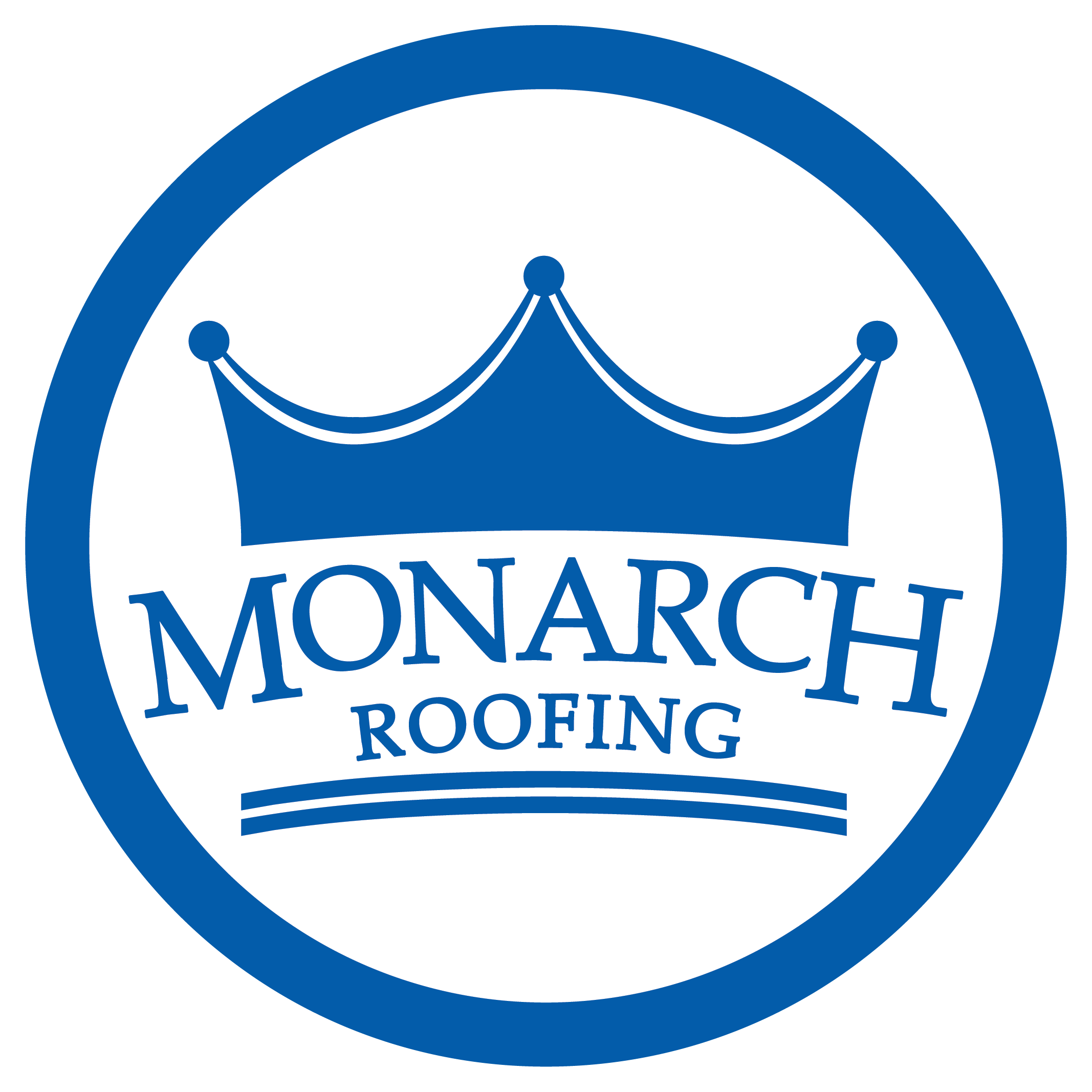Many homeowners find great joy in doing their own hands-on work around the house. And we don’t blame you! Whether it be painting a bedroom, tiling the kitchen floor, or doing something much bigger like a bathroom remodel, accomplishing such a feat can boost confidence and save you money in the process. Plus, it’s fun to see the look on your friends’ faces when you say it was all you.
Some highly motivated homeowners may even try their hand at DIY roof installation.
While we always recommend homeowners hire a professional roofer to handle any roofing project, but if you have the skills and the tools to handle a DIY roofing project, give it a go! Just be sure to read our thorough roof installation DIY guide, first, please.
Tools and Materials Required for Roof Installation
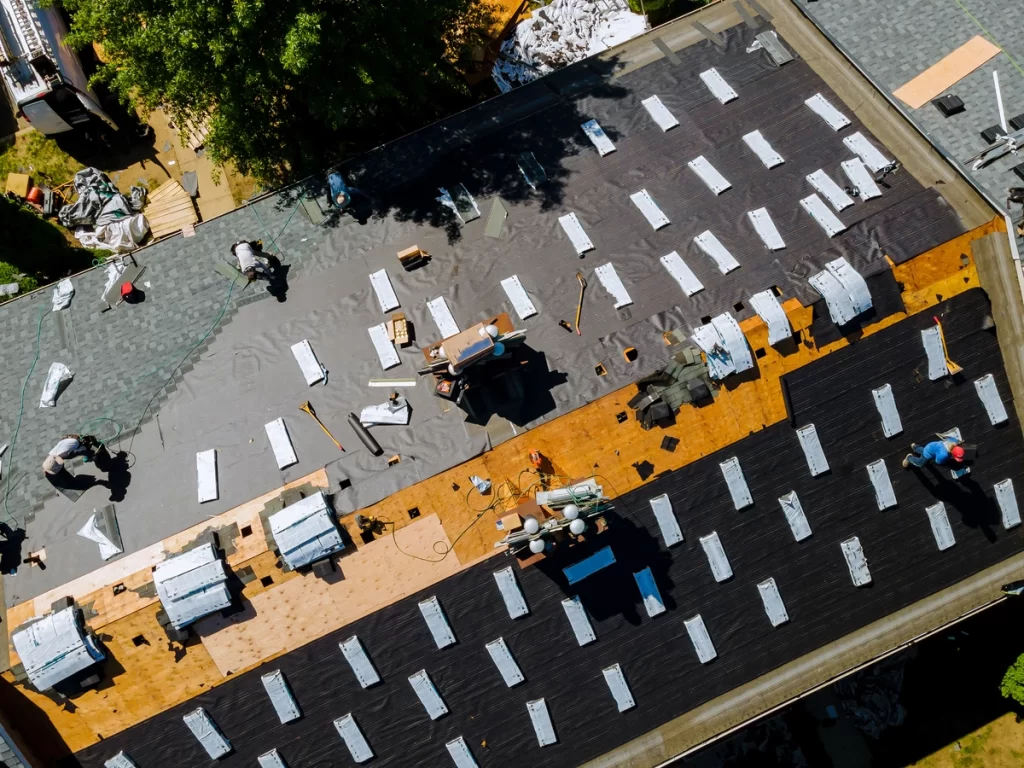
While a lot of DIY chores require tools or materials you might have lying around the house, roofing is a little more specific— requiring some specialty tools to get the job done. Before you begin, make sure you have these tools on hand, plus your bundles of shingles, of course.
- Air compressor
- Caulking gun + caulk
- Chalk line tool
- Extension ladder
- Gripping work boots
- Roof safety harness
- Roofing nailer + nails
- Staple gun + staples
- Straightedge razor
- Tin snips
- Toolbelt
- Utility knife
- Work gloves
In addition to these tools, you’ll also need to pick up a few materials to properly install a roof.
- Drip edge
- Felt underlayment (#15 or #30)
- Flashing
- Sealant
- Shingles
Now that you have everything you need, you can get started! Our tips below will help even the inexperienced homeowner navigate the complex process of roofing a house. However, when in doubt, always call a professional for a job done right!
Homeowner Tips for DIY Roof Installation
Installing a roof is no small feat, but if you’re determined to do it yourself, we have some tips to help ensure your safety and the quality of your roof.
Tip #1: Safety First 🦺
When you’re ready to start working on the roof, be sure to take all the necessary safety precautions. This includes wearing gloves, eye protection, and closed-toed shoes. You should also set up your ladder securely and have someone hold it in place while you’re working.
We highly recommend a roofing safety harness to prevent fatal falls as well. Even the pros who are up on the roof every day use harnesses to ensure their ultimate safety doing this dangerous job. Even a short fall can be fatal, so take the proper precautions. Here’s a list of the best roofing harnesses to use.
Tip #2: Don’t Go It Alone 🧑🤝🧑
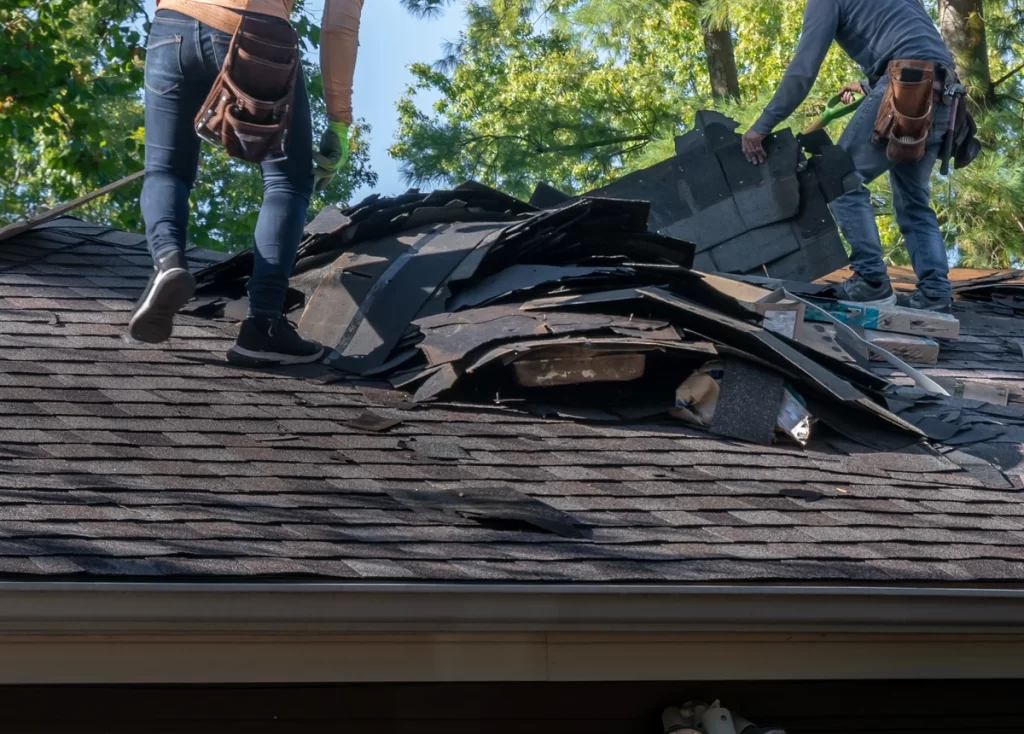
Whenever you’re doing any house projects where you’re up on a ladder or using power tools, or dealing with electrical work— you should definitely grab a buddy to help. Working with a friend or family member ensures you always have someone to hold the ladder, unplug the power tool, or get help should you need it. It can help prevent accidents, plus you have someone to join in on the fun! It can be very tough to do roofing stuff by yourself, so enlist the help of 1 or more people.
Tip #3: Have a Plan of Action 📜
Before beginning any work on the roof, inspect it from the ground with binoculars. This will give you a better idea of what needs to be done and help you create a game plan. Having a well-thought-out and organized plan of action will ensure nothing gets missed along the way.
Professional roofing teams have these processes in place and quality checks along the way to ensure not even one nail is out of place. But homeowners attempting the DIY route can’t say the same.
Checklists that can’t be completed until you check off each step can help. For example, writing down the parts of the roof (detailed below) and what needs to be done first will be huge. Then having a roof installation checklist to finalize at the end will ensure you aren’t getting back up on that roof in 3 months to fix a leak.
Tip #4: Know the Parts of a Roof 🏠
Before you start roofing, it’s important to know the different parts of a roof so you can identify any issues and make repairs as needed. The roof is made up of several layers, including the roof deck, underlayment, shingles (or roofing material), flashing, and gutters. The main parts of a roof include:
1. Drip edge: This is the metal edge that is installed along the roof line. It helps direct water away from the roof and into the gutters.
2. Flashing: This is the material (often metal) that is installed in roof valleys and around chimneys, skylights, and vents. It helps direct water away from these areas and keeps it from leaking through those vulnerable seams.
3. Gutters: Yes, your gutters are part of the roofing system. Without them or if they get clogged, you risk roof leaks and damage.
4. Ice and water shield: This is a waterproof barrier that is installed along the roofline and in roof valleys. It helps protect the roof from water damage. You probably won’t see this in desert climates or areas that don’t experience a lot of rain or snowmelt each year.
5. Plumbing boots: These are installed around the top of plumbing pipes that escape from your roof to keep water from seeping in through these openings.
6. Ridge cap: The ridge cap is installed along the roof peak and helps protect the roof from water leaks and damage. It creates a solid, watertight seal where the two sides of your roof meet at the peak.
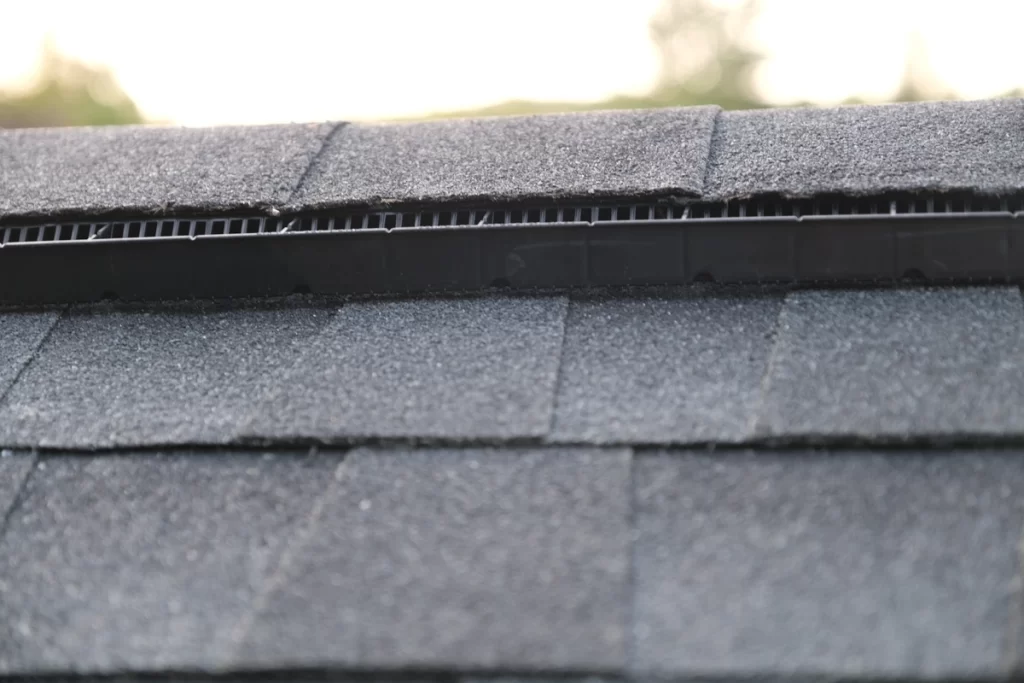
7. Roof decking: This is the plywood or OSB (oriented strand board) that serves as the roof’s base. It’s what your roofing material is nailed into.
8. Roofing material: There are many different roofing materials from asphalt shingles to metal and cedar shakes. It can be worth comparing the many various kinds to determine which one will work best for you. Some are more DIY-friendly than others (like asphalt shingles)— learn more here.
9. Roof vents: Roof vents are installed along the roofline and help ventilate the attic space. Proper roof ventilation is vital to ensuring your roof stays in good condition and you don’t experience trapped moisture, mold or mildew growth, or high energy bills. It can also keep your heating and energy bills lower.
10. Soffit and fascia: These are the boards that cover the roof eaves (soffit) and roof edges (fascia). They help protect the roof from water damage and leaks and provide ventilation from the attic. They are also a huge part of the aesthetic appeal of your home’s exterior.
11. Starter shingles: Starter shingles will be one of the first pieces of material you install on your roof. They help seal the roof’s edge and prevent water leaks and act as the guiding lines for the rest of the roof installation.
12. Underlayment: This is a waterproof barrier that is installed between the roof deck and roofing material.
Tip #5: Know Your Limits 🙅
With all of that being said, the best tip we can give DIY homeowners is to know your abilities and your limits. Don’t get started on something that you don’t know if you can finish because, with a roofing job, you can get underwater fast.
The last thing you want is to be half done with a roof and have to call in the big dogs to help you because you are starting to work beyond your expertise. Know when to ask for help, know what you can handle on your own, and roof away. But most importantly, stay safe up there! Use ladders correctly, don’t work in inclement weather, and take all the necessary safety precautions.
Pros and Cons of DIY Roof Installation ⚖️
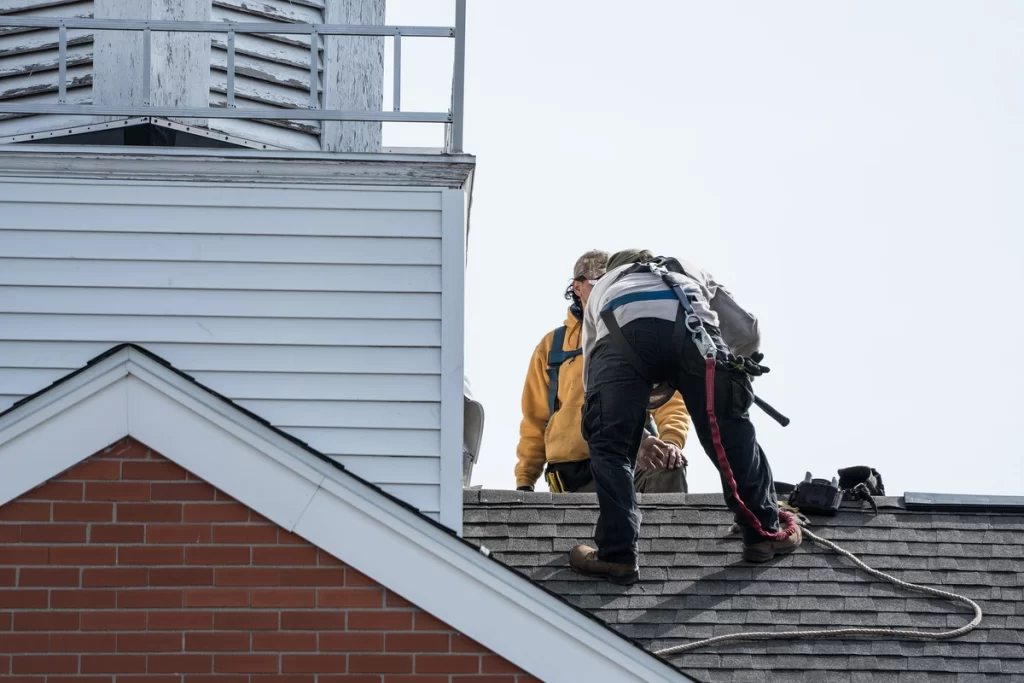
With any home project, there are pros and cons that must be weighed before you begin. Because once you swing that first hammer, there’s no going back. And when it comes to roof installation, you’re going to want to know what you’re getting into before you start tearing off those shingles— trust us.
First, let’s start with the pros:
✅ You Can Save Money
If you’ve ever hired someone to fix something on your house or your car, you know very well how much of the end cost is made up of parts and labor. Cutting out the labor aspect can definitely save you a ton of money upfront.
✅ You Work On Your Own Timeline
Maybe you’ve been let down by unreliable contractors in the past, or maybe you just have a very full schedule, and finding a time that works to get your roof done is hard to do. Doing it yourself does allow you to work on your own timeline, whether it’s a longer time frame or shorter— you have control, which is very important to many homeowners.
✅ Feeling of Gratification
There’s no doubt about it, doing a roof installation DIY project and then sitting back to survey your work is an incredibly gratifying experience. If you’re the type of person who gets satisfaction from a job well done, this is definitely a pro for you!
Now, let’s look at some of the cons of DIY roof installation:
❌ The Job Can Take Longer
If you have a roof that’s in pretty good condition and only needs a few repairs, doing it yourself might not be too big of an undertaking. But if your roof is older or in disrepair, it could take much longer to complete the project than anticipated.
Professional roofers can install a roof within a day because they do so many of them, but the inexperienced homeowner is going to hit a lot of snags along the way that can prolong the project. Plus, without a big team of people, it can take longer as well.
❌ Easily Overwhelming
There’s a reason roofing is an entire profession— it can be incredibly overwhelming to the average person. There are a lot of tools and materials involved, and if you’re not familiar with roofing, it can easily become too much.
❌ You Could Make Mistakes
Making mistakes is inevitable when you’re doing any kind of home improvement project, but roofing is one of those projects where mistakes can be very costly. One wrong move could result in a roof leak, and that’s something you definitely want to avoid.
❌ You Might Void Insurance or Warranties
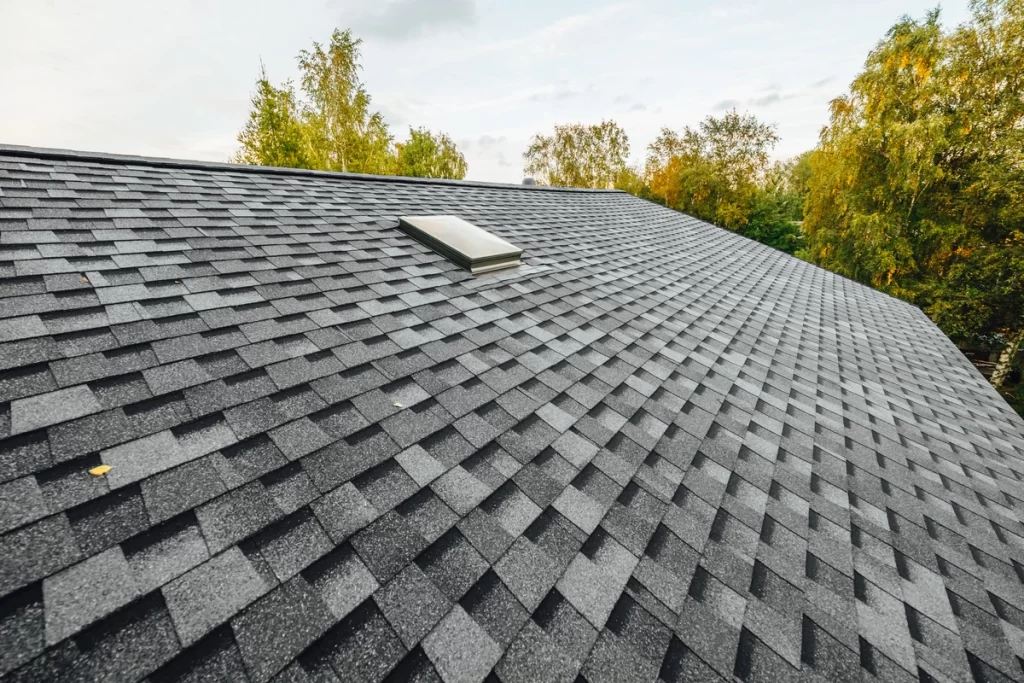
Those mistakes we mentioned above can actually void insurance claims or warranties. Be very mindful when you take on a roofing project so as not to replace a roof you still have under warranty or attempt to fix storm damage repairs on your own when an insurance claim may have been your saving grace. Failed repairs are one of the most common reasons a claim gets denied, so weigh the benefits of doing it yourself vs. getting the help you need first.
❌ You Can End Up Spending MORE Money
You might be thinking that since roofing is so expensive, you’ll save money by doing it yourself. But if you make mistakes or the project takes much longer than expected, you could end up spending even more money in the long run.
You also need to consider the tools and materials you’ll need to purchase and the fact that contractors often get manufacturer discounts for buying in bulk, whereas you’ll be paying retail prices at the hardware store without the added benefits of additional warranty options that professionals can offer.
❌ It’s a Dangerous Job
Roofing is one of the most dangerous jobs out there. It involves working at heights, using power tools, and handling heavy materials. One wrong move could result in a serious injury or even death.
So, what’s the verdict? Is roof installation a DIY project you should take on or leave to the professionals? Weigh your options carefully and make the best decision for you and your roof. Roof installation is a big job that requires expertise and safety precautions. It’s quite an undertaking, so why don’t you just call the pros instead?
Skip the DIY and Call the Pros 👷
When it comes to roof installation, we recommend skipping the DIY route and calling Monarch Roofing instead. Yes, it’s an investment, but your roof is one of the most important parts of your home, and it’s not worth risking your safety or voiding warranties by attempting to do it yourself.
With Monarch Roofing, you never have to go it alone. From our insurance guidance process to outstanding warranties and financing options, interested homeowners can rest easy knowing their roof is taken care of and they don’t have to worry about a thing. Doesn’t that sound better than DIY? If you’re curious to learn more— reach out today!
